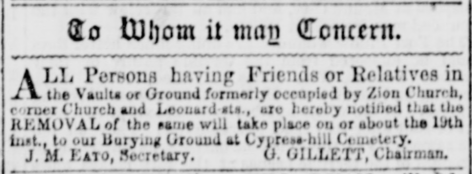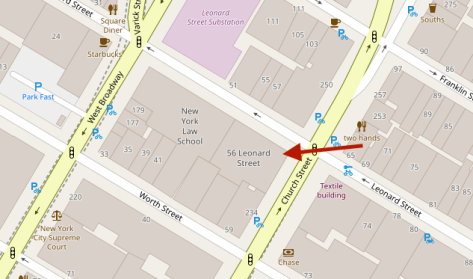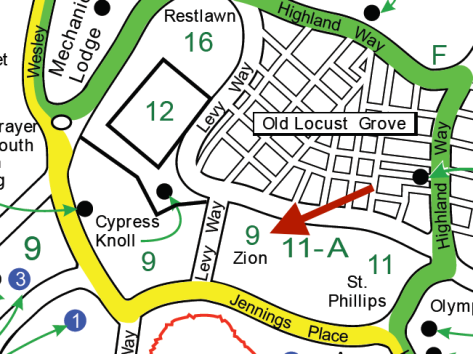
“This Is Not Cypress Hills Cemetery” reads a sign immediately inside the gate at Maimonides Cemetery in Brooklyn. It’s easy to understand why disoriented visitors stumble into Maimonides by accident—its gate is located a short distance eastward of the entrance to the large, nondenominational Cypress Hills Cemetery on Jamaica Avenue and it, along with the adjacent Mount Hope Cemetery, is nestled into a notch of land cut along Cypress Hills’ southeast border. These two small cemeteries are timeworn today—especially their grand entrance buildings, which are targets of graffiti and vandalism— but in the late 19th-early 20th century, Maimonides and Mount Hope were among the fashionable burial grounds of New York’s Jewish community.

Maimonides Benevolent Society was formed in 1853 by a group of “wealthy Hebrews of New York City” to assist one another in times of illness and difficulty and to look after the needs of their community. Soon after this mutual aid society was organized, a plot in Cypress Hills Cemetery was purchased as a burial ground for its members. When this plot became full, they purchased, in 1879, 8 acres of land adjoining Cypress Hills to establish a new cemetery for the association as well as for other Jewish societies and families. The red-brick gatehouse on Jamaica Avenue was built in 1892 and by 1900 about 1,700 bodies had been interred in Maimonides’ grounds. To meet the need for more burial space, Maimonides Benevolent Society eventually purchased more land in Elmont on Long Island and continues to operate both cemeteries today. Maimonides Cemetery in Brooklyn is notable as the burial place of two pioneering motion picture executives—Marcus Loew, founder of the Loew’s theatre chain and Metro-Goldwyn-Mayer (MGM) studios; and Joseph Schenck, an early president of United Artists and co-founder of Twentieth Century Pictures, which later became 20th Century Fox.

In 1881, members of several other Jewish fraternities and societies—including the Free Sons of Israel and Phoenix Widows’ and Orphans’ Aid Society—that had also outgrown their earlier burial grounds at Cypress Hills and elsewhere, formed Mount Hope Cemetery Association and purchased 12 acres of land immediately east of Maimonides Cemetery to establish a new cemetery. Like Maimonides, they sold plots to Jewish societies and families, and by 1900 3,000 individuals were interred here. The cemetery’s administration building, which replaced an earlier gatehouse constructed when the cemetery was established in 1881, was recognized by the Brooklyn Chamber of Commerce’s building awards competition when it was built in 1931. Although tattered and covered with graffiti now, this elegant Art Deco structure, and Mount Hope’s beautifully intricate ironwork entrance gates, are gems hidden in the chaotic surroundings of Jamaica Avenue.

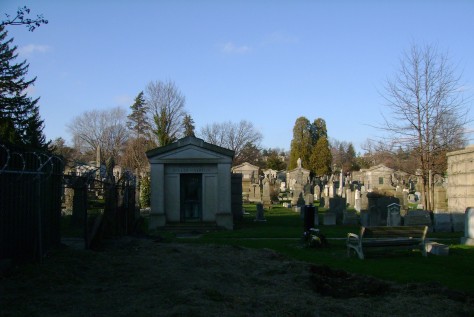
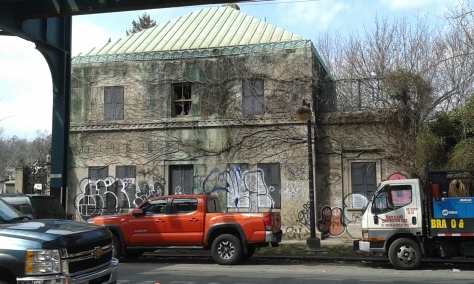


View more photos of Maimonides and Mount Hope cemeteries.
Sources: Hyde’s 1905 Atlas of the Borough of Queens Vol. 4 Pl. 10; “Maimonides Cemetery—A New Hebrew Burying Ground,” Brooklyn Daily Eagle Oct 6 1879; [Classified Ad], The Jewish Messenger July 30 1880; “Local News—Maimonides Benevolent Society,” The Jewish Messenger Sep 16 1892; The Leonard Manual of the Cemeteries of New York and Vicinity (1901), 52, 55-56; Maimonides Cemeteries; “The City—Mount Hope Cemetery,” The American Hebrew Sept 2 1881; “Local News—A New Cemetery,” The Jewish Messenger Sept 16 1881; “Chamber Cites Boro Buildings Erected in 1931,” Brooklyn Daily Eagle Feb 21 1932; NYCityMap


